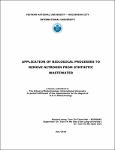| dc.description.abstract | The reduction of the nitrogen present in wastewaters to an environmentally supportable
level is essential, since an excess of nitrogen to receiving waters would lead to several
environmental and health risks. The supernatant from anaerobic digestion of protein rich
organic materials, such as sewage sludge, piggery wastewater, seafood processing or
organic fraction of municipal solid waste is a typical highly ammonium loaded wastewater
that needs to be treated. For the treatment of these kind of wastewaters, biological nitrogen
removal is preferred in front of other chemical or physico-chemical processes because of it’s
cost aspects, chemical and energy requirements, operation experience, process reliability
and environmental impact. The conventional biological nitrogen removal (BNR) process
consists on the oxidation of ammonia to nitrate (nitrification) and the reduction of nitrate to
nitrogen gas (denitrification) using biodegradable COD as electron donor.
In this study, a simply biological system treatment was designed to carry out nitrification by
aerobic process and denitrification by anoxic process in separated reactors. Over the course
of the investigation, the hydraulic retention time of the anoxic and aerobic reactors was 23
hours, in order to establish steady state conditions. Wastewater was removed and re-feed
every day. Under experimental controlled condition, nitrification did not occur. Therefore, no
Nitrogen-nitrate and Nitrogen-nitrite were produced in effluent. Nitrifying bacteria did not
activate, VSS/SS ratio decreased. It is attributed to several un-well control condition.
Though bad results were achieved from this experiment, it is a good chance for the author
to understand that well controlling of operational conditions in the bio-reactor is the most
important factor if it is expected to get accurate results. Though denitrification had a shorter
time to reach steady state, the efficiency of N-NO3- removal in these reactors were very
good. In the reactor 7, N-NO3- reduced from 50 mg N-NO3-/L in the influent to
approximately 0.2 mg N-NO3-/L in the effluent (about 99.6%). In the reactors 8, these
values were 75 mg N-NO3-/L to nearly 10 mg N-NO3-/L (about 86.7%), and in the reactor 9
from 100 mg N-NO3-/ to 20 mg N-NO3-/L (80.00%). DO concentration in the reactor 8 and 9
were higher than 2.0 mg/L and it is attributed to lower removal efficiency of these reactors. | en_US |


